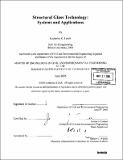| dc.contributor.advisor | Jerome J. Connor. | en_US |
| dc.contributor.author | Leitch, Katherine K. (Katherine Kristen) | en_US |
| dc.contributor.other | Massachusetts Institute of Technology. Dept. of Civil and Environmental Engineering. | en_US |
| dc.date.accessioned | 2006-02-02T18:58:10Z | |
| dc.date.available | 2006-02-02T18:58:10Z | |
| dc.date.copyright | 2005 | en_US |
| dc.date.issued | 2005 | en_US |
| dc.identifier.uri | http://hdl.handle.net/1721.1/31200 | |
| dc.description | Thesis (M. Eng.)--Massachusetts Institute of Technology, Dept. of Civil and Environmental Engineering, 2005. | en_US |
| dc.description | Includes bibliographical references (leaves 70-73). | en_US |
| dc.description.abstract | Glass cannot compete with steel in terms of strength or durability, but it is the only structural material that offers the highly sought after qualities of translucency and transparency. The use of glass has evolved from purely decorative or architectural to structural, encouraging glass technologies to advance concurrently with increased demand. As a result, contemporary methods used to produce structural glass provide excellent strength characteristics, particularly after treatments including annealing, tempering, and heat-strengthening, which reduce its vulnerability to cracking and sudden brittle failure. Its modulus of elasticity is roughly equal to that of aluminum-greater than both wood and concrete-but doesn't allow any plastic deformation. Lamination dramatically improves both the strength and durability of glass by joining strengthened layers of glass using resin or a polyvinyl butyral foil. No comprehensive design code is currently available to aid in the design of structural glass members. The behavior of glass is examined through a variety of structural applications including beams, columns, walls, roofs and floors, and domes. Case studies are explored to underscore the technical principles discussed for each structural glass element utilized in place of more traditional building materials. | en_US |
| dc.description.statementofresponsibility | by Katherine K. Leitch. | en_US |
| dc.format.extent | 73 leaves | en_US |
| dc.format.extent | 4127222 bytes | |
| dc.format.extent | 4134781 bytes | |
| dc.format.mimetype | application/pdf | |
| dc.format.mimetype | application/pdf | |
| dc.language.iso | eng | en_US |
| dc.publisher | Massachusetts Institute of Technology | en_US |
| dc.relation.requires | CDROM contains thesis in .doc format. | en_US |
| dc.rights | M.I.T. theses are protected by copyright. They may be viewed from this source for any purpose, but reproduction or distribution in any format is prohibited without written permission. See provided URL for inquiries about permission. | en_US |
| dc.rights.uri | http://dspace.mit.edu/handle/1721.1/7582 | |
| dc.subject | Civil and Environmental Engineering. | en_US |
| dc.title | Structure glass technology : systems and applications | en_US |
| dc.type | Thesis | en_US |
| dc.description.degree | M.Eng. | en_US |
| dc.contributor.department | Massachusetts Institute of Technology. Department of Civil and Environmental Engineering | |
| dc.identifier.oclc | 61398836 | en_US |
